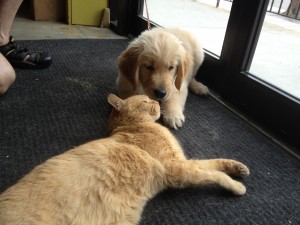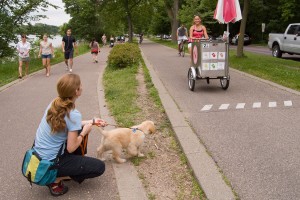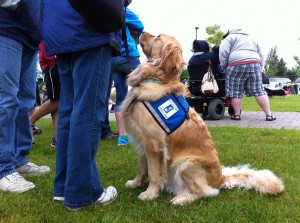Think about the dogs you’ve known.
How many of them had some kind of quirk? Stella, a neighbor’s dog, did not like bikes. She barked like crazy whenever a cyclist went by—including me. I once helped my neighbor chase down Stella as she chased after a cyclist. Some dogs don’t want to walk on wet grass. They freak out if they hear a train. They bark at people in hats. Think about the dogs you’ve known. What were their quirks?
Now, think about a service dog and the myriad of situations she will find herself in, situations normal dogs never encounter: the city bus, grocery store, place of employment, restaurants, etc. Imagine the trouble it would cause if the dog won’t walk across a metal grate or board a bus or barks at the bearded coworker, etc.
Imagine that the person who spooks the dog is really important to her human’s life—a coworker or a home care assistant. Imagine that person is from a country where people don’t keep dogs as pets or is afraid of dogs. If the service dog is not absolutely well behaved, the dog will jeopardize that relationship. There are any number of reasons a person and a dog won’t get along, among them are because the dog does not know how to respond to the person’s beard or skin color or manner of dress.
Seva is at that age when things that make an impression on her, both the positive and negative, imprint permanently. Her future behavior is being shaped by her exposure and reactions to people and things now. This is the age of socialization.
Part of my job is to make sure she meets all kinds of people in a friendly, supportive manner. Fortunately, most people like puppies and she is really cute!
On Sunday, Scott and I took Seva to Urbanimal. I knew we’d have a good time in Uptown, and I was right. Urbanimal has a totally mellow shop cat named Ben. Seva saw Ben as just another four-legged-friend and was in immediate pursuit. She sniffed Ben, then licked him, tail wagging nonstop. When Ben had had enough, he swatted Seva, which she took as an invitation to wrestle, puppy style. This was where we intervened—to save our puppy. I think Ben could take care of himself.
Then it was off to Lake Calhoun and the busiest trail in town.
Seva can walk nicely. Really, she can. But, boy, you put a few hundred people around her with bikes, blades, strollers, and dogs…forget about it! She did not know what to do with herself. She was too stimulated to even open her mouth for a piece of kibble, never mind listen to me. I kept a tight grip on a short leash and managed her enthusiasm.
Seva met a bunch of people and dogs on the trail. She got a close-up look at some in-line skates, and she watched an ice cream bike go by. She wanted to meet every person and every dog she saw, whether they wanted to meet her or not. When she’s tugging at the leash to meet someone and he passes her by, I swear it hurts her feelings. I know I’m anthropomorphizing, but you should see the look on her face. Seriously, if you ever see us on the street, make sure you stop to say hello. And if you’re wearing mirrored sunglasses or a giant hat or a welder’s mask, all the better.
(Also see Me and My Shadow.)





